Denatured and Industrial Alcohol
“A TREATISE ON THE HISTORY, MANUFACTURE, COMPOSITION, USES, AND POSSIBILITIES OF INDUSTRIAL ALCOHOL IN THE VARIOUS COUNTRIES PERMITTING ITS USE,AND THE LAWS AND REGULATIONS GOVERNING THE SAME, INCLUDING THE UNITED STATES. WITH CONCISE TABLES, METHODS, AND NOTES FOR THE USE OF THE ENGINEER, CHEMIST, MANUFACTURERS OF ALCOHOL AND ALCOHOL MAKING AND USING APPARATUS, INCLUDING ALCOHOL MOTORS, ENGINES, ILLUMINATING LAMPS, AND HEATING AND COOKING STOVES”
THE enactment of legislation by Congress on June 7, 1906 (permitting the general use of tax-free domestic alcohol, after it has been suitably denatured, for industrial purposes and for light, heat, and power) immediately created a wide-spread interest and inquiry throughout the United States as to the facts relating to the whole matter.
The scarcity of literature treating the subject of Denatured or Industrial Alcohol was so great that there were practically no books concerning it. This book was therefore prepared. The author had the honor to represent the American Chemical Society and the Society of Chemical Industry, through their New England sections, in favor of Denatured Alcohol, at the so-called "Free Alcohol" Congressional hearings, held in Washington, D. C., February–March, 1896, on the matter of repealing the internal-revenue tax on domestic alcohol after it had been suitably denatured. The testimony given at these hearings was from a great variety of sources and possessed a highly educational value and interesting character, many important abstracts from such testimony are given in this book under their appropriate subjects.
There is also a very complete list, on page 494, from the Patent Review, New York, of all the important patents relating to improvements in the manufacture of alcohol and in alcohol-distilling apparatus for the twenty years prior to the books original publication.
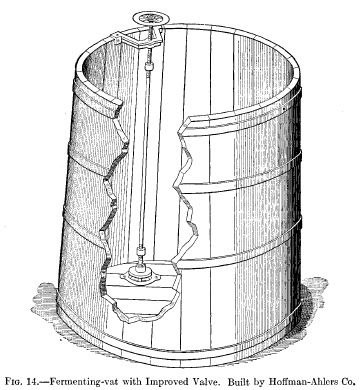 |
The author defines fermentation as the change induced in organic matter through the agency, direct or indirect, of micro-organisms or their enzymes. The fermenting-vats used vary in size according to circumstances. In Fig. 14, page 34, is shown the improved manner of operating the valve in the bottom, which discharges the mash.
|
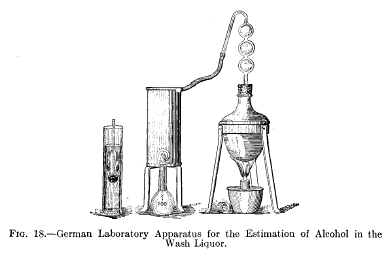 |
To prepare absolute alcohol, quicklime, anhydrous copper sulphate, and metallic sodium are employed. For the distillation, in determining the amount of alcohol formed in a fermentation at least a half-liter should be used, and larger amounts, up to 2 or 3 liters, are probably preferable.
The distillation is carried out in a glass or metal flask, and the alcoholic vapors are condensed in a tube, or worm, surrounded by cold running water, and collected in a receiver. A German laboratory apparatus for this purpose is shown in Fig. 18. A specially made small alcohol hydrometer and jar is shown at the left of this cut. The heat is supplied by burning denatured alcohol.
Practically all the alcohol will be contained in an amount of the distillate equal to two fifths of the alcoholic solution taken. This is then accurately made up to the original volume and the specific gravity determined by the pycnometer.
|
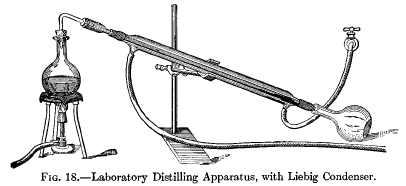 |
Fig. 18 shows an apparatus that consists of a glass flask (or a retort) in which a liquid or liquid mixture is boiled and the condenser into which the vapor thus formed is conducted and by which it is recondensed, the distillate being collected in the receiving-flask.
This form of condenser consists of two tubes between which a current of cold water flows in an upward direction or opposite to the flow of the distillate. The inner tube of this condenser as well as the outer is sometimes made of glass and in some instances of metal.
|
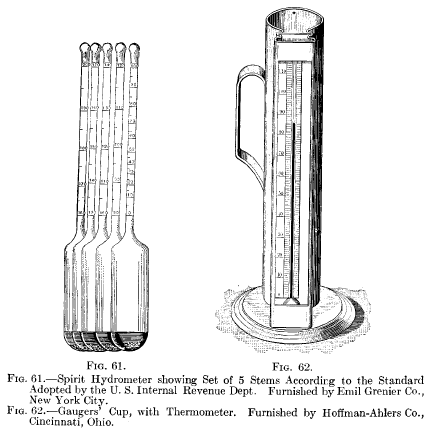 |
In testing spirits for their alcoholic strength in per cents of proof by tables given on pages 143-145, a gauger's cup, shown in Fig. 62, p. 142, and alcohol hydrometers, shown in Fig. 61, p. 142, are used. Proof or 100 will be indicated on the hydrometer when the temperature of the spirit is at 60° F. Tables for correction of temperature when it varies from 60° F. are supplied in this manual.
The gauger's cup is filled with the spirit to be tested according to the directions in this manual, and the hydrometer is carefully placed therein and the degree or per cent proof is read from the scale on the stem at the surface of the spirits according to these published directions. A complete set of five stems according to the Standard of the U. S. Internal Revenue is shown in Fig. 61, ranging from water marked 0 to absolute alcohol marked 200.
|
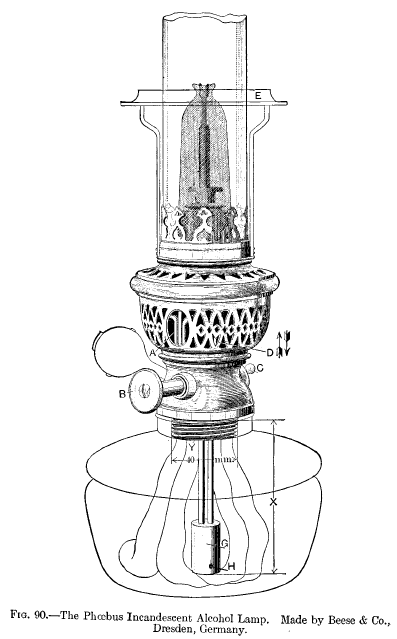 |
In describing the Phoebus Incandescent Alcohol Lamp, of which a cut is shown in Fig. 90, it may be said that the manipulation of this lamp is practically the same as those heretofore described in this chapter. The lamp is lighted at A by a match. It is extinguished by closing the screw vapor-valve B. In filling the lamp the alcohol is put in at the orifice C. D is the regulator. For a table lamp for reading purposes a shade is placed upon the support E. The small rubber bulb shown, when compressed, forces a little alcohol into the lighting chamber A. This bulb is readily detachable, being provided with a metallic connection. The lamp is here shown without the base in order to show the details. Any design and material is supplied for the base by the manufacturers.
|
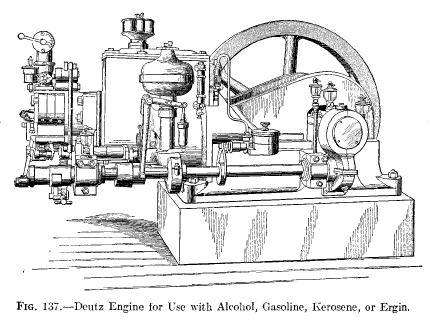 |
Shown in Fig. 137, p. 275, is an illustration of the Deutz alcohol engine, type E-12, of 20 horse-power. The original Otto or Deutz engines were built in Germany for a period of about forty years, the Otto engines types E-10, M-10, and E-12 were single-acting explosive engines. The cylinder being closed at one end, a mixture of air and gasoline, kercsene or alcohol vapor was exploded in the cylinder, the resulting pressure moved a piston which transmitted power through the connecting-rod and crank to the fly-wheel shaft.
|
|